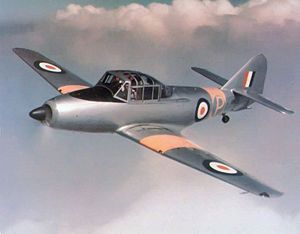| Athena
|

|
| Avro Athena T.1 prototype with turboprop engine
|
| Role
|
Trainer Type of aircraft
|
| Manufacturer
|
Avro
|
| First flight
|
12 June 1948
|
| Introduction
|
1950
|
| Primary user
|
Royal Air Force
|
| Number built
|
22 (including prototypes)
|
The Avro 701 Athena is a British advanced trainer aircraft built by Avro in the late 1940s. It was designed to replace the North American Harvard in the Royal Air Force, but was bought only in small numbers, the competing Boulton Paul Balliol being preferred.
Design and development
The Athena was designed to meet the requirements of Air Ministry Specification T.7/45 for a three-seat advanced trainer powered by a turboprop engine for the RAF. The Athena was an all-metal low-winged monoplane, with a side-by-side cockpit. The Air Ministry rethought its requirements in 1947 and replaced the original specification with Specification T.14/47, which specified the use of a Rolls-Royce Merlin 35 piston engine, large stocks of which were held in store.[1]
Despite the change in specification, the first three prototypes were of the turboprop-powered Athena T.1, the first of which, powered by an Armstrong Siddeley Mamba engine, flew on 12 June 1948 at Woodford Aerodrome.[1] The Merlin-powered Athena T.2 first flew on 1 August 1948,[2] and was evaluated against the similar Boulton Paul Balliol.
A small production run of 15 Athenas was ordered for the RAF, but the Balliol was preferred, and no further Athenas were ordered.
Operational history
The 15 production Athenas were used by the RAF from 1950[3] for armament training at the RAF Flying College at RAF Manby.[4] A single aircraft was loaned back to Avro and given the civil registration G-ALWA for a demonstration tour of India. No sales resulted and it was returned to the RAF.[1]
Accidents and incidents
Two of the 22 aircraft were lost in flying accidents:
- T2 VR569 of the Aircraft Instrument Experimental Unit was written off at Wilby, Suffolk on 27 June 1951. Aircraft broke up in spiral dive after loss of control in cloud, two crew killed.[5]
- T2 VR570 crashed before delivery on 20 March 1950.
Specifications (Athena T.2)
Data from Jane's all the World's Aircraft 1949-50,[6] Avro aircraft since 1908,[1] The Incomplete Guide to Airfoil Usage[7]
General characteristics
- Crew: 2
- Capacity: 720 lb (330 kg)
- Length: 37 ft 4 in (11.37 m)
- Wingspan: 40 ft 0 in (12.2 m)
- Height: 12 ft 11 in (3.93 m) a/c level with tail up
- Wing area: 270 sq ft (25 m2)
- Aspect ratio: 5.93
- Airfoil: root: H/1414/37.5 (14%); tip: H/1410/37.5 (10%)
- Empty weight: 6,384 lb (2,896 kg)
- Gross weight: 8,130 lb (3,688 kg)
- Fuel capacity: 110 imp gal (130 US gal; 500 L) in two flexible wing tanks and 30 imp gal (36 US gal; 140 L) in a fuselage collector tank, with provision for 90 imp gal (110 US gal; 410 L) in two under-wing drop tanks; Oil: 15 imp gal (18 US gal; 68 L)
- Powerplant: 1 × Rolls-Royce Merlin 35 V-12 liquid-cooled piston engine, 1,280 hp (950 kW) for take-off
- 1,245 hp (928 kW) combat rating at 11,500 ft (3,500 m)
- 1,060 hp (790 kW) continuous cruise at 9,250 ft (2,820 m)
- Propellers: 4-bladed constant-speed propeller
Performance
- Maximum speed: 293 mph (472 km/h, 255 kn) at 20,000 ft (6,100 m)
- Cruise speed: 223 mph (359 km/h, 194 kn) max at 10,000 ft (3,000 m)
- Stall speed: 81 mph (130 km/h, 70 kn) flaps down
- Range: 550 mi (890 km, 480 nmi)
- Service ceiling: 29,000 ft (8,800 m) service ceiling
- Rate of climb: 2,050 ft/min (10.4 m/s) initial; 2,030 ft/min (10.3 m/s) at 10,000 ft (3,000 m)
- Wing loading: 30.1 lb/sq ft (147 kg/m2)
- Power/mass: 6.4 lb/hp (3.9 kg/kW)
- Take-off run to clear 50 ft (15 m): 745 yd (681 m) off concrete; 770 yd (700 m) off grass
- Landing run over 50 ft (15 m): 740 yd (680 m) on concrete; 710 yd (650 m) on grass
Armament
Aircraft of comparable role, configuration, and era
Related lists
